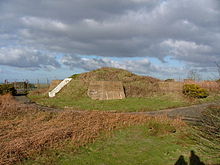| St Boniface Down | |
|---|---|
 | |
| Highest point | |
| Elevation | 241 m (791 ft) |
| Prominence | 241 m (791 ft)(island highpoint) |
| Listing | Marilyn, Hardy, County Top |
| Coordinates | 50°36′12.46″N 1°11′55.43″W / 50.6034611°N 1.1987306°W / 50.6034611; -1.1987306 |
| Geography | |
 | |
| Location | Isle of Wight, England |
| OS grid | SZ568785 |
| Topo map | OS Landranger 196 |


St Boniface Down is a chalk down near Ventnor, on the Isle of Wight, England. Its summit, 241 metres (791 ft), is the highest point on the island, with views on a clear day stretching over 70 miles from Beachy Head to the east, Walbury Hill to the north, the Isle of Portland to the west and the French coast of Normandy to the south. It is 1 kilometre (0.6 mi) north of the town. There is reputed to be a wishing well on its southern slope, which requires the wisher to climb up from the south without looking back. In 1545, a French invasion force attempted this against a force of the Isle of Wight Militia commanded by Sir John Fyssher – which allegedly included several women archers- and were routed. In 1940, the radar station was bombed by Ju 87 Stuka dive bombers, which is reconstructed in the film "The Battle of Britain". The top is surmounted by a round barrow.
At the eastern foot of the down, on the A3055 road between Bonchurch and Luccombe, a path descends into Bonchurch Landslips via a scenic rock cleft, the Devil's Chimney.
Wildlife
St Boniface Down is home to the largest cricket species within the British Isles, the great green bush cricket.
The area includes some unusual plant communities including acid grassland and heathland, resulting in parts of the Down being designated as a Site of Special Scientific Interest. The gravel capping supports extensive tracts of gorse Ulex europaeus with intervening areas of heathland and acid grassland dominated by heather Calluna vulgaris, bell heather Erica cinerea, purple moor-grass Molinia caerulea, bristle bent Agrostis curtisii and locally bilberry Vaccinium myrtillus. The occurrence of heathland on deep gravel overlying chalk, the naturalised holm oak woodland and the juxtaposition of heath and chalkland vegetation are all unusual biological features in Britain.
Cultural references
St Boniface Down is also the name and was the inspiration of a 1956 work by the English composer, Trevor Duncan.
References
- ^ Bathurst, David (2012). Walking the county high points of England. Chichester: Summersdale. pp. 60–64. ISBN 978-1-84-953239-6.
- "St Boniface Down, England". Peakbagger.com. Retrieved 11 January 2009.
- Natural England citation sheet for Ventnor Downs SSSI
50°36′12″N 1°11′55″W / 50.60346°N 1.19873°W / 50.60346; -1.19873
This Isle of Wight location article is a stub. You can help Misplaced Pages by expanding it. |